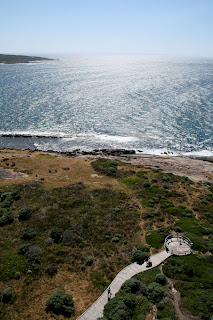But if I sound like I’m complaining, I’m not. Moving on every day means you see something different every day – and this weekend has been an extremely varied one because of it.
I left Kalgoorlie on Friday and spent hours driving past waving golden fields which held more wheat than the entire Ashes cricket team could hope to eat in a lifetime, and through the down-at-heel and downright depressing communities that have sprung up to tend to it. The fact that one was called Grass Patch might give you some idea as to the dubious highlights that pass for being attractions in these parts, and I was relieved to reach New Norcia after seven hours horizon-chasing.
Sadly this relief was short-lived. The architecture of this somewhat random monastic community is truly stunning when you compare it to the surrounding flat fields but unfortunately, though my hotel for the night looked grand from the outside, inside it was more akin to that hostel Leo stays in in The Beach. Paint was peeling off the walls, the rowdiness of the bar downstairs could be heard through the paper-thin walls and the ceiling fan whirred annoyingly and managed to be ineffective at the same time. Having been used to air con, flatscreen TVs and, well, having my own bathroom, I became instantly sulky at having to share facilities and cope without so much as a tap to call my own. The service didn’t help – it was by far the worst I’ve had here – and I went to bed with a storm cloud over my head to match those building outside.
Fortunately the next day I was heading back to the coast and, after a look around the outside of the beautiful monastic buildings accompanied by a flock of galahs, I sped off westwards towards the coast and Cervantes. This tiny crayfishing town would be nowhere near the tourist trail were it not for one, rather magical, thing: the Pinnacles, and there is an air to the town that seems to suggest they would rather not bother, thanks all the same. They may not have to for much longer in fact, thanks to the brand-new bitumen of the Indian Ocean Drive which has cut the journey time from Perth and ended the need to get anywhere near the town unless you specifically want to, but for now it’s the only place to stay if you want to view the Pinnacles at sunset – which I did.
 The Pinnacles are bizarre rock formations which poke through the sand, forming a sea of columns across a vast area of sand dune. I joined Mike Newton’s Turquoise Coast Enviro Tour for a three-hour trip out to see them in the hope that this time I would understand a bit more about the natural phenomenon that caused these geological marvels. Thanks to Mike I now do, although I wouldn’t like to try and explain it without the help of numerous diagrams and possibly the internet. Suffice to say they’re amazing, and utterly unique. I was spellbound by them again and watching the sun set between them was an unforgettable experience.
The Pinnacles are bizarre rock formations which poke through the sand, forming a sea of columns across a vast area of sand dune. I joined Mike Newton’s Turquoise Coast Enviro Tour for a three-hour trip out to see them in the hope that this time I would understand a bit more about the natural phenomenon that caused these geological marvels. Thanks to Mike I now do, although I wouldn’t like to try and explain it without the help of numerous diagrams and possibly the internet. Suffice to say they’re amazing, and utterly unique. I was spellbound by them again and watching the sun set between them was an unforgettable experience.From Cervantes I was heading further north up the coast but it turned out, as it so often does here, that the road was in fact miles inland and offered only more agricultural land as a backdrop to my day. Fortunately it wasn’t far to Geraldton, a suburban-feeling town which had nothing besides fine weather to offer on a Sunday afternoon. I lapped it up of course and wasn’t the least bit upset at my enforced relaxation time due to a lack of internet and open attractions to visit.
The town’s museum was open this morning so I learned all about the dangers of boarding a boat anywhere near this coast in the Shipwreck Galleries and discovered that it is here that some of the earliest evidence of life on earth leaving the water for land can be seen. It was fascinating and left me with a greater respect for Geraldton – a great museum is a rare thing after all.
My destination today was Kalbarri and this time the drive really did take in some coastal scenery – and spectacular scenery at that. The sandstone coast along here has been gradually eroded by the water and there are gorges and striated cliffs stretching for several kilometres south of the town. I popped happily on and off the highway, diving down access roads to viewpoints and short walking trails, and snapping away to try and capture the rich red, brown and ochre colours of the rock. Hopefully I succeeded enough to help me remember it.
My day ended with roast duck on the terrace of the Grass Tree restaurant while the setting sun turned the sky blazing red and gave the water a beautiful rosy glow. I may have had to drive several thousands of kilometres to get here but every last one was worth it for that and although I’m not looking forward to packing up the car – again – tomorrow morning, I am looking forward to where it will take me next.












